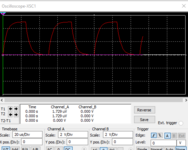Amr Wael
Member level 5
Hello ,
i am trying to design a low pass filter using the simple RC configuration , I have selected the values for the resistor and capacitor to be 10 nF and 390 Ohms for the cut off frequency to be around 40k.
My problem is that the rise time of a 20Khz signal entering this filter is making the digital pulse really bad. I know that the rise time and the cut off frequency are related through the following equation Tr = 0.35/fdB.
My question is there a method to decrease the rise time without affecting the cut off frequency ?
or should I use a different type of filter ?
This is a reference for the relationship between the rise time and the BW.
 and attached is a photo of a simulation for the filter at the values mentioned before.
and attached is a photo of a simulation for the filter at the values mentioned before.
i am trying to design a low pass filter using the simple RC configuration , I have selected the values for the resistor and capacitor to be 10 nF and 390 Ohms for the cut off frequency to be around 40k.
My problem is that the rise time of a 20Khz signal entering this filter is making the digital pulse really bad. I know that the rise time and the cut off frequency are related through the following equation Tr = 0.35/fdB.
My question is there a method to decrease the rise time without affecting the cut off frequency ?
or should I use a different type of filter ?
This is a reference for the relationship between the rise time and the BW.

Relationship Between Rise Time and Bandwidth for a Low-Pass System
Thorlabs specializes in the building blocks for laser and fiber optic systems. From optomechanical components to telecom test instrumentation, Thorlabs' extensive manufacturing capabilities allow us to ship high quality, well priced components and devices for next-day delivery. Optomechanics...
www.thorlabs.com
